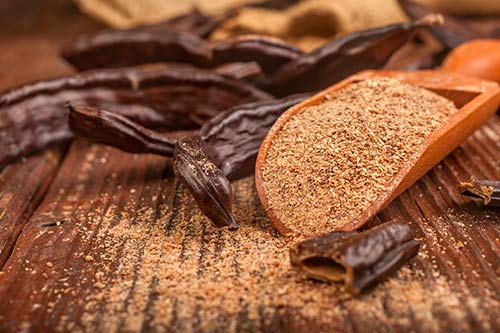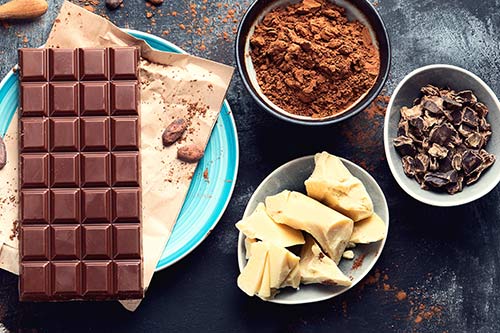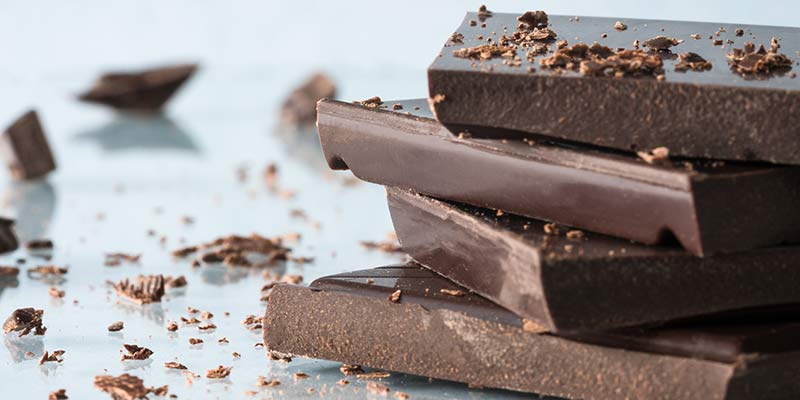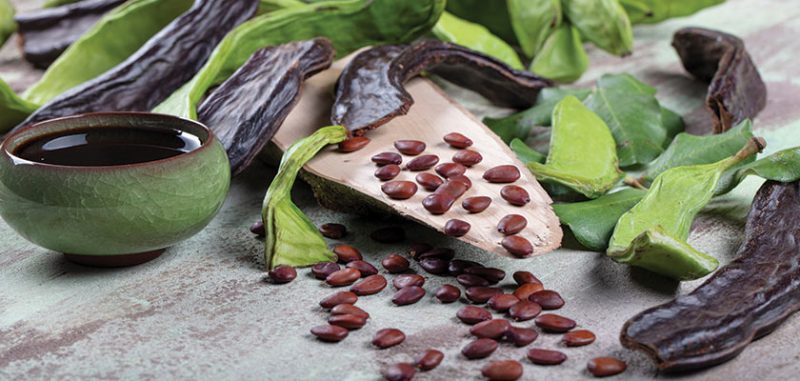Wondering how to make carob chocolate bars and treats, like those from the shop? In this deep dive, professional chocolatier Simon Knott explains how to make carob chocolates at home using traditional chocolate-making principles.
Carob is enjoyed by many as a healthier alternative to chocolate, packed full of vitamins and minerals that aren’t as present in cacao. While it’s not exactly like chocolate, the flavor of carob is comparable enough that there exists a wide range of commercial carob chocolates and carob chocolate bars, all resembling chocolate in packaging, look and even taste.
But, how can you achieve the same real-chocolate results when making carob chocolate bars and treats at home? A quick internet search shows a gazillion results for carob bars that resemble homemade granola bars, but that’s not what we’re talking about. We mean real carob chocolates… you know, the type that looks and feels like real chocolate.
In this tutorial, professional UK chocolatier Simon Knott draws on his chocolate-crafting experience and training, to show you how to achieve comparable results with carob. After reading this article and some practice, you’ll be able to make your own carob chocolates and carob chocolate bars at home, which look and feel like real cacao-based chocolate.
Let’s now hand over to Simon.
How to Make Carob Chocolate Bars that Resemble ‘Real’ Chocolate
By Simon Knott, Professional Chocolatier
Introduction to carob chocolates
Carob rapidly gained popularity in the West in the 1950s, 1960s and 1970s. The growing health markets promoted it as a healthier product than chocolate, although much of the science to back this up during these decades wasn’t particularly sound. Even so, it started to gain widespread acceptance as a replacement ingredient for chocolate, mainly in baked recipes and desserts, as I discuss in detail in my article on cacao vs carob here.
The carob tree (Ceratonia siliqua) produces distinctive pods and has been cultivated in the Mediterranean and the Middle East for hundreds of years. Carob tree fruits grow as long green pods when unripe, which turn dark brown as they ripen. On harvesting, the inside of the pod, containing the soft pulp and hard seeds, is separated for different uses. These range from pharmaceutical and cosmetic applications to numerous benefits in recipes. The pulp is often used separately to act as a thickening agent in food manufacture, where it is often known as locust bean gum.
How does making carob chocolate bars compare with making ‘real’ chocolates?
In many ways, making carob chocolate bars is a lot simpler than making cacao chocolates. One of the most complex parts of making cacao chocolates revolves around the tempering process’s agitation, heating, and cooling. Even experienced chocolatiers have slip-ups with tempering, whether due to the weather, human error, or the chocolate. Tempering isn’t an issue for someone making carob chocolates, and the most important element of the recipe is thoroughly mixing the ingredients instead.
Different Textures
Using tempering to make chocolates with cacao and cocoa butter creates a rigid crystal structure, giving the finished product an enjoyable ‘snap’ when broken and eaten. Carob chocolate recipes are often made using coconut oil, which is liquid at room temperature. However, without any setting crystal structure, the chocolate can be prone to melting in the hand. This problem can be remedied by replacing the coconut oil with cocoa butter, which, as well as creating a firmer texture, will reduce the coconut flavor in the finished product.
No Tempering with Carob Chocolates
In conventional cacao chocolates, heating, cooling, and stirring are all employed to create the optimum crystal structure. In carob chocolates, the crystal structure is much less defined, even when cocoa butter is substituted for coconut oil. Consequently, without the need to adhere to strict temperature control during production, making carob chocolates is much simpler and less risk-prone.
Fats
Compared to Cocoa/cacao ingredients, carob is low in natural fats. To ensure carob chocolate products have adequate fat to create the enjoyable melting mouth feel we all enjoy in conventional chocolate products, fat must be supplemented in coconut oil or cocoa butter. The choice is subjective, although coconut oil carob chocolates will tend to melt quicker in the hand than cocoa butter-based carob chocolates, and the coconut oil will transfer a slight flavor of coconut.
Sweetness
Cacao powder is very bitter and has a very low natural sugar content. This is usually supplemented with sugar to create the sweetness everyone enjoys in chocolate products. Conversely, carob pods are naturally sweet from the sugars the tree generates during growth. This can amount to 30-50% of the weight of the carob pod in sucrose.
Nutrition
Because of its less dynamic flavor profile than chocolate, carob often struggles to compete. However, regarding nutrition, cacao chocolate and carob offer a complex range of benefits. Both offer antioxidant and anti-inflammatory properties and a range of minerals. Additionally, growing research suggests carob can inhibit cancer cell growth, reduce cholesterol, and improve blood sugar regulation. Unlike cacao chocolates, carob chocolates won’t contain any theobromine, which can be toxic to pet dogs.
“…a 60/40% blend of cacao/carob is ideal.”

Ingredients in Carob Chocolates & Carob Chocolate Bars
Carob
Carob pods have their natural sweetness and can be used as a powder, chip, or syrup ingredient in cakes, biscuits, and puddings. Carob is often used as a substitute for chocolate for its sweet, toasted flavor or for nutritional benefits such as the lack of caffeine and theobromine typically found in chocolates.
The carob in any recipe serves a dual function. It acts as the primary flavouring agent, which gives the chocolate its appeal. Additionally, the natural sweetness of carob means less sugar or syrup needs to be added to create the required sweetness. Some chocolatiers prefer to use roasted carob powder in their recipes. They claim the roasting process accentuates the existing carob flavours and simultaneously reduces bitterness.
To make carob chocolates, you can use either:
Carob Powder
Carob powder is produced by thoroughly drying the whole carob pod and removing the hard seeds. The remaining carob pod pulp is ground to a fine powder, similar in appearance and texture to cocoa powder.
Carob Chips
Carob chips are commercially prepared by combining carob powder, oil or fat such as coconut, avocado, cocoa butter, sugar (refined or unrefined), honey and vanilla. The oil or fat is gently melted, and the remaining ingredients except the vanilla are stirred in until the mixture is smooth and no longer gritty. The mixture is removed from the heat, and the vanilla is stirred through it before pouring it into a flat tray. The mixture is allowed to set in the freezer and can then be sliced into very small cubes or chips.
It’s essential to read the additives when buying carob chips. It’s not unusual for unsustainable palm oil, dairy ingredients, or even gluten to be included in the recipe.
Sugar / Sweetener
The sugar required in a carob chocolate recipe will usually be less than that in a cocoa chocolate recipe. Carob powder or chips contain a naturally higher percentage of sugar in the form of sucrose formed in the pod.
The style of sweetener you choose for your recipe comes down to your own personal preferences. Granulated sugar will sweeten like maple syrup, but the latter may have a more exciting flavour. Possible sweetening agents include agave syrup, maple syrup, honey, and sugar (as unrefined as you prefer). If you use a crystalline sweetener, it will be necessary to heat the ingredients to dissolve the crystals for a smooth finished product.
What purpose does sugar/sweetener serve?
Whichever form of sweetener you employ in your carob chocolates, it will serve several functions beyond just sweetening. Sugar is a vital texture modifier in a recipe that adds body to the other ingredients, making the finished chocolate more satisfying. Sugar also has a role as a flavor enhancer, where it intensifies the flavour elements such as carob and vanilla. Lastly, sugar is a popular preservative because it reduces the water activity in a product, stopping microbial growth.
Butter or Oil
As with the sweetening agent, the choice of fat in the recipe primarily comes down to personal preference. Coconut oil and cocoa butter are popular choices (and sometimes a mixture of both) as they are set at higher temperatures than other fats, giving structure to the carob chocolates. This is why sunflower and vegetable oil are not a good choice, as they are permanently liquid at room temperature. Some recipes use nut butter, such as almond, as a source of the fat. Here, the fat source is combined with the protein from the nut kernels, which helps to stiffen the mixture without setting.
What purpose does fat/oil serve?
The fat or oil in a carob chocolate serves several functions. At a physical level, the thickening or solidifying of the fat gives structure to the chocolate to make it easier to eat. The recipe’s fat component also helps improve the ‘mouth feel’ as the product is consumed. The richness in the mouth created by the combination of carob, sugar and fat produces a particularly satisfying and enjoyable experience.
“…the fat proportion must be 30-40% of the total mass.”
Recipe: Pure Carob Chocolate Bars (Cacao-free)
This first recipe, loosely inspired by a recipe shared by Oatmeal with a Fork for carob cinnamon-pecan candies, uses only carob as the base. This recipe is the closest result you will be able to achieve to real chocolate, using carob only. In the next recipe, further down, we explain how to make carob chocolate bars using a blend of carob and cacao to achieve even more chocolate-like resemblance.
Tools and Equipment
- A mould or small tray to pour your carob chocolate mixture into
- Silicone paper to line your tray – if required
- Spatula, stirring spoon and tablespoon.
- Small saucepan
- Sieve
Ingredients
- 4 tablespoons coconut oil
- 2 tablespoons carob powder or chips
- 2 tablespoons maple syrup or sugar (granulated takes longer to dissolve than powdered/icing sugar)
- 1/4 teaspoon vanilla extract or pod
Method
- If using the tray, cut your silicon paper to the correct size and line it.
- Spoon the coconut oil into the saucepan and gently heat it on the cooker until melted.
- Remove the pan from the heat.
- Sieve the carob powder into the melted coconut oil.
- Add the syrup or sugar and the vanilla.
- Stir with the spoon until all ingredients are dissolved/amalgamated.
- Scrape the mixture into the tray and smooth the top using the spatula.
- Transfer the tray to the freezer and chill for 40 minutes.

Recipe: Cacao Carob Chocolate Bars
In this second recipe, we explain how to make carob chocolate bars with cacao and carob in a 50/50 blend. This allows you to achieve a result that more closely resembles real chocolate, and enjoy the authentic flavor of cacao alongside the health benefits of carob. If you don’t have an aversion or allergy to cacao, we suggest you try this method.
Tools and Equipment
- A chocolate bar mould or small tray to pour your carob chocolate mixture into
- Silicone paper to line your tray – if required
- Spatula, stirring spoon and tablespoon.
- Small saucepan
- Sieve
Ingredients
- 115g cacao butter
- 3 tablespoons carob powder
- 3 tablespoons cacao powder
- 2 tablespoons honey
- 1 tablespoons almond butter
- 1 teaspoon vanilla paste
Method
- If using a tray, cut the silicon paper to the correct size and line it.
- Sieve the carob powder and cacao powder into the saucepan.
- Measure the remaining ingredients except the vanilla paste.
- Heat gently and stir regularly with the spatula until smooth.
- Take the pan off the heat and allow to cool slightly.
- Stir in the vanilla paste until dispersed.
- Scrape the mixture into the tray or mould, and smooth with the spatula.
- Transfer the tray/mould to the freezer for 40 minutes.
- Remove from the freezer. Unmould the chocolates, or if using a tray, cut the carob chocolate into individual squares or bars. Store the carob chocolate bars in an airtight box or silicone paper.
Benefits of Blending Carob with Cacao
Reduced bitterness
To many people, the bitter nature of chocolate is one of its most vital assets. However, for others, this same bitterness can spoil their enjoyment of chocolate products. Research has shown that reducing the cacao content by combining it with carob powder creates an enjoyable flavoring which is far less bitter than cocoa alone. An optimum split of a 60/40% blend of cacao/carob is ideal. This is also more usable in recipes with good solubility and higher in several nutritional elements.
Interesting flavour variation
Cacao powder has a distinctive and robust flavour that easily overpowers other ingredients’ taste. However, when carob powder is used alongside cacao powder, it can offer a new and exciting dimension to the overall flavour profile. Carob is often described as having an earthy and caramel flavour, which complements the flavour of cacao products well.
How to Customize Your Carob Chocolate Bars
Oils and liqueurs
Just a couple of peppermint or orange oil drops can quickly transform carob chocolate, but use sparingly. Freshly grated zest can also be added, but this is best sliced very small. Similarly, liqueurs such as Amaretto or Frangelico can easily add a sophisticated touch. Again, go sparingly. The alcohol in the liqueurs may affect the texture of the chocolates.
Nuts
Major chocolate producers have added nuts to their chocolate ranges for years. They are popular because they add exciting texture contrasts to the chocolate, and, at the same time, if they are roasted, their flavours complement the chocolate as well. Apart from allergies, there are no reasons to restrict the use of nuts, and some of the most popular varieties include almonds, hazelnuts, peanuts, macadamia, and pistachio.
Freeze-Dried Fruit
Customising chocolate bars with fruit pieces was problematic because of their short shelf life before freeze-drying. However, with all the water removed, freeze-dried fruit pieces have all the flavour and texture that complement chocolate so well and a good shelf life.
Typical fruit flavour varieties that match carob chocolates include strawberry, raspberry, sour cherry, apple, blackberry, and blackcurrant.
Sea Salt
We add salt to our food to bring out the flavors contained within it. As such, we can add a small amount of salt to carob chocolates to do the same and highlight the existing flavors. Which salt you choose depends on personal preference, although sea salt is often the most popular. This is because the crystals tend to be larger and dissolve on the tongue in a much more appealing way than table salt ever could.
Carob Chocolate Bars Troubleshooting & Tips
Make sure you use enough fat
To ensure your carob chocolate bars are uniform in texture, stable and have an enjoyable mouth feel, the fat proportion must be 30-40% of the total mass.
Stovetop vs Microwave
Frequently, recipes recommend heating the ingredients gently, directly on the stove or using a double boiler, where the heat source never exceeds 100° C. However, some chocolatiers prefer to use a microwave as the heat source, as they find the heating time more controllable. However, it is necessary to take care when using a microwave, as it can create hotspots and burn the chocolate. Consequently, it’s best to use shorter, low-power bursts of microwaving with regular stirring in between.
Store carob powder correctly for good flavor
Taking care when storing carob powder is essential because several factors will affect the strength of its flavour over time:
- Carob powder doesn’t have a powerful flavour even when fresh.
- As a fine powder, carob has a very high surface area, which means the volatile flavour components can escape more quickly than if it were a solid.
- More flavouring is lost each time the packet or container is opened to the air.
So, in storing carob powder, keep it in the container you bought until you need to use it. If you can’t reseal the container effectively, transferring their carob into a resealable container is best. Storing the carob in dark, dry conditions is best, as with most spices and herbs. The carob powder should remain usable for at least 12 months, depending on how many times you open the container. The storage for carob chips is similar, but as the carob component is fixed within the chip, the flavour should endure longer.
Conclusion
We hope you’ve enjoyed this article from Simon Knott on how to make a carob chocolate bar that resembles real chocolate, and that this has inspired you to give it a try at home yourself. As a personal tip, as a carob-lover, I suggest you source carob pieces rather than ground carob powder, and grind the pieces into powder yourself at home using a coffee grinder when needed. This will help retain some of the fresh flavor in your baking and carob chocolate making.
To learn more about the benefits and characteristics of carob, be sure to check out our article on introduction to carob written by me (Ayla Marika), and delve into a more scientific exploration of carob vs cacao chocolate by Simon Knott to gain a deeper understanding of these ingredients.
Happy carob-tiering!





